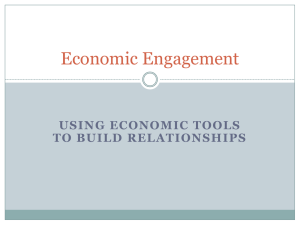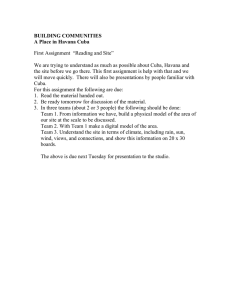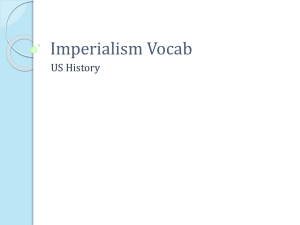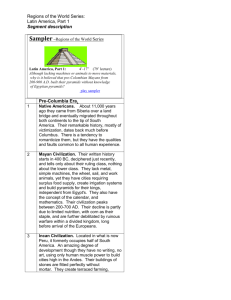O B ?: L
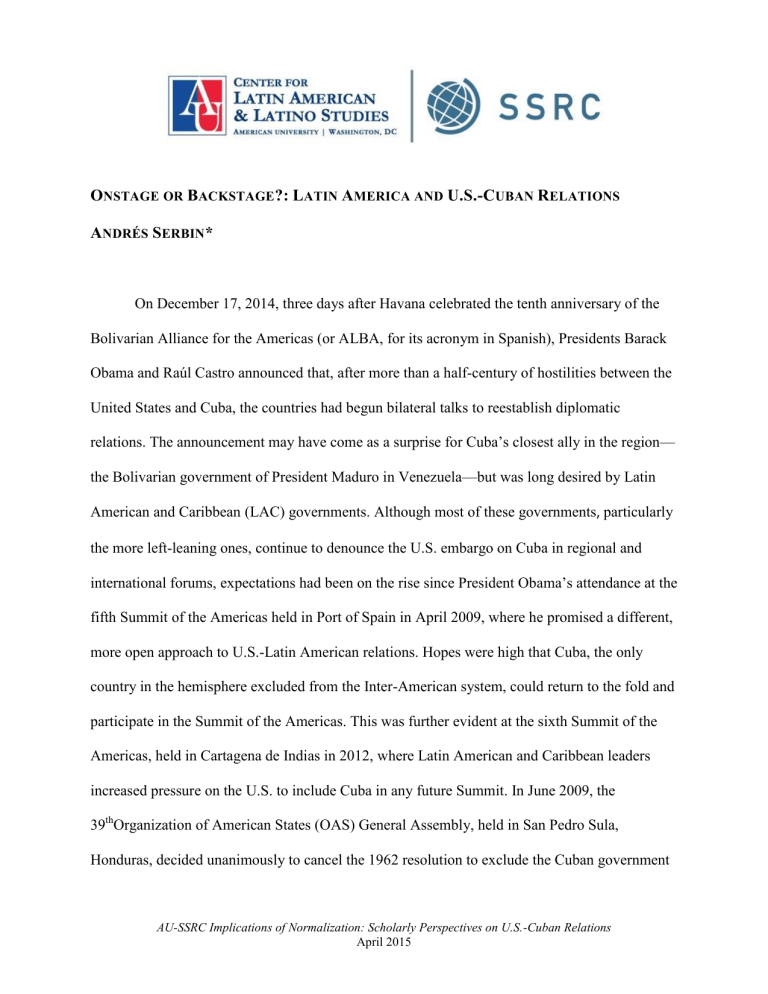
O NSTAGE OR B ACKSTAGE ?: L ATIN A MERICA AND U.S.-C UBAN R ELATIONS
A NDRÉS S ERBIN *
On December 17, 2014, three days after Havana celebrated the tenth anniversary of the
Bolivarian Alliance for the Americas (or ALBA, for its acronym in Spanish), Presidents Barack
Obama and Raúl Castro announced that, after more than a half-century of hostilities between the
United States and Cuba, the countries had begun bilateral talks to reestablish diplomatic relations. The announcement may have come as a surprise for Cuba’s closest ally in the region— the Bolivarian government of President Maduro in Venezuela—but was long desired by Latin
American and Caribbean (LAC) governments. Although most of these governments , particularly the more left-leaning ones, continue to denounce the U.S. embargo on Cuba in regional and international forums, expectations had been on the rise since President Obama’s attendance at the fifth Summit of the Americas held in Port of Spain in April 2009, where he promised a different, more open approach to U.S.-Latin American relations. Hopes were high that Cuba, the only country in the hemisphere excluded from the Inter-American system, could return to the fold and participate in the Summit of the Americas. This was further evident at the sixth Summit of the
Americas, held in Cartagena de Indias in 2012, where Latin American and Caribbean leaders increased pressure on the U.S. to include Cuba in any future Summit. In June 2009, the
39 th
Organization of American States (OAS) General Assembly, held in San Pedro Sula,
Honduras, decided unanimously to cancel the 1962 resolution to exclude the Cuban government
AU-SSRC Implications of Normalization: Scholarly Perspectives on U.S.-Cuban Relations
April 2015
from the organization, confirming that most LAC governments—and not just those aligned with
ALBA—were committed to Cuba’s rapid reincorporation into the hemispheric community.
Even though the U.S.-Cuban bilateral talks started in December 2014 after a year of secret interventions by the Vatican and Canada, a key pending question is whether LAC governments contributed in any way to this dialogue, given their increasing autonomy from the
United States and the rapidly changing hemispheric relations. To answer this question, it is important to elaborate on two important factors that played into this process: 1) the changing landscape of regional governance after the end of the Cold War and the events of September 11
(leading to the gradual strategic disengagement of the U.S. from Latin America as the priorities of its regional agenda narrowed to the war on drugs and immigration); and 2) the cautious approach taken by some key LAC countries in influencing the U.S. position towards Cuba. The two factors are intertwined: Latin American regionalism emerged through the creation of several regional organizations—such as ALBA, the Union of South American States (UNASUR), and the Community of Latin American and Caribbean States(CELAC)—that excluded the United
States and Canada, and Brazil, Mexico, and Venezuela played leading roles in this process. But a third, additional factor should not be underestimated. Since the seventies, when Cuba began to establish closer ties with the Caribbean Community (CARICOM) countries, until the nineties, when Cuba was admitted to the Latin American Integration Association (ALADI, for its acronym in Spanish) after the collapse of the Soviet Union, Havana developed a consistent foreign policy strategy of broadening and deepening its relations with Latin America within its international policy of “concentric circles.” This strategy benefitted from the gradual accession to power of like-minded left-wing or populist parties and movements—most of which were members of the regional left-parties Sao Paulo Forum—which sympathized with Cuba’s
2
revolution. Seasoned and skilled Cuban diplomacy was crucial both for developing closer ties with LAC countries and for preparing the way for U.S.-Cuban bilateral talks.
The new Latin American regionalism and its impact on hemispheric relations
Since the 1950s, Latin American regionalism has evolved in three distinct stages. The first phase took place between the 1960s and 1980s (when U.S. hegemony remained strong) and was built around the aspiration for greater regional autonomy through the creation of regional markets and regional strategies of industrialization and import substitution. A second phase took shape at the end of the 1980s and the beginning of the 1990s. Heavily influenced by the so-called
“Washington Consensus” and the concept of “open regionalism” espoused by the Economic
Commission on Latin America, a neoliberal approach was introduced, which focused on trade liberalization, economic opening, and the elimination of trade barriers. Trade, investment, and economic issues dominated the new regional agenda. However, in 2005, after negotiations concerning the Free Trade Area of the Americas collapsed during the Summit of the Americas held in Mar del Plata, new modalities of regional political cooperation, as well as social and economic integration, began to emerge. Dubbed “post-liberal” or “post-hegemonic,” these new forms of regionalism have centered on creating regional organizations that prioritize political coordination, intergovernmental arrangements, and a new regional agenda.
The current phase reflects the profound changes that the international system has undergone and their effects on the region. After the end of the Cold War and especially after
September 11, 2001, the United States reoriented its strategic priorities and has generally paid less attention to Latin America (apart from its closest neighbors Mexico, Central America, and the Caribbean). This has weakened both U.S.-LAC relations and the inter-American system in
3
general, which has been criticized strongly by Bolivarian governments. At the same time, the euro crisis precipitated the decline of the European presence in the area. Links among Latin
American states grew, but not through a single and coherent process of regional integration.
India, Korea, and particularly China have increased their presence in Latin America, as Japan did earlier, but they currently limit their ties mostly to the economic realm. Other actors, such as
Russia and Iran, are also establishing closer ties with the region. For its part, Latin America is looking for new partners in a world characterized by the “rise of the rest,” as put by Fareed
Zakaria.
Looking for increasing autonomy
As a result, the international system is showing greater signs of multipolarity and polycentrism. Latin American countries, particularly in South America, are using the new international juncture to exhibit greater autonomy from the United States. In this context, over the past decade, regional organizations with varying political, economic, and ideological approaches have been created in Latin America. In 2004, Cuba and Venezuela formed the
Bolivarian Alternative for the Peoples of Our America, later renamed the Bolivarian Alliance for the Peoples of Our America (ALBA). The Venezuelan-funded organization promotes South-
South cooperation and assistance, all while espousing strident anti-U.S. rhetoric. In May 2008, after a long process led mostly by Brazil, UNASUR was founded in Brasília, bringing together12
South American states, including Guyana and Suriname, two countries that have traditionally been linked to CARICOM. In February 2010 in Cancun, all of the LAC governments collaborated to form CELAC, another inter-American organization that, like ALBA and
UNASUR, excludes the United States and Canada. CELAC took over the role of the Rio Group,
4
which had served as a forum for political coordination and consultation since the 1980s. Since its inauguration, CELAC has developed a series of extra-regional dialogue initiatives with actors such as the European Union, China, India, and Russia, a process which recently culminated with a Sino-Latin American Summit in Beijing. Finally, the Pacific Alliance—founded in 2012 by
Colombia, Chile, Peru, and Mexico—started out fundamentally as a revitalized free trade agreement between these countries, but now several observer states like Panama and Costa Rica are in the process of joining the bloc. Pacific Alliance members stand to gain from the Trans-
Pacific Partnership.
Nevertheless, the dominant trend of political coordination and increasing autonomy from the United States (whether cautious or stridently radical) has prevailed in the region for the last
15 years, notwithstanding the region’s persistent fragmentation and lack of consolidated institutions. Within this context, Cuba has been consistently invited to attend regional summits and high level meetings, and has become a regular participant at most of the major regional political events. Cuba and different Latin American countries and regional organizations have also signed various treaties and agreements, and Cuba was one of the founders of CELAC.
Cuba’s inclusion within the LAC community culminated at the third Summit of CELAC, held under Cuban pro-tempore presidency in Havana in January 2014. Latin American and Caribbean presidents and heads of states participated, and the Secretary General of the OAS attended. The event led to declarations of support to the Cuban government and denunciations of the U.S. embargo on the island.
Key Latin American Players
5
In the crusade for Cuba’s inclusion in the LAC community, Venezuela (and particularly
Chávez’s charisma and regional influence) played an important role, particularly since ALBA’s establishment. But Brazil’s subtle and cautious support and leadership, especially that of Lula da
Silva, was also a key factor in this process, even if the country’s stance towards the U.S. was less openly antagonistic, given the political and economic costs of a more radical attitude towards
Washington. More cautious still was the Colombian government’s position, even after President
Santos’ re-election in 2014. Although the U.S. has historically been one of Colombia allies, Cuba has played a fundamental role in the dialogues between the Colombian government and the
FARC and ELN guerrillas, and helped significantly to dilute tensions between Colombia and
Chávez’s government. Before the creation of CELAC, Mexico was initially left out of the process, despite its important historic ties with Cuba before the irruption of a crisis during the
Fox administration, but finally followed suit in supporting Cuba during the Calderón and, more recently, Peña Nieto administrations, as did the rest of the South American and Caribbean countries (Bolivarian or not) and some of the Central American nations. Nevertheless, the
Panamanian government’s decision to invite the Cuban government to attend the seventh
Summit crystallized the regional process of Cuba’s full inclusion into the hemispheric community, notwithstanding different voices that expressed distrust regarding Cuba’s commitment to democracy, its human rights record, and the reach of the economic reforms in the island.
However, there is no way of measuring the real influence of individual Latin American and Caribbean governments and countries in the process of Cuba and the U.S.’ reestablishment of bilateral relations. What is clear is that most of them supported cancelling Cuba’s suspension from the OAS and, through statements and declarations by the newly formed regional
6
organizations, were key to creating a solid foundation from which to pressure the United States for Cuba’s full reincorporation into the hemispheric community, as illustrated by their preparations for the seventh Summit of the Americas. In any case, even if the bilateral talks that started in December 2014 were solely the result of sovereign decisions made by both the U.S. and Cuban administrations without any direct intervention, pressure or facilitation by the LAC, the recent changes in the regional environment were propitious for initiating this process and were clearly a factor influencing the current U.S. administration.
Moving ahead, the seventh Summit of the Americas in Panama may bring some surprises.
It remains to be seen how future rounds of Cuba-U.S. talks will develop; how both governments’ representatives will behave at the Summit; and how the current reconfiguration of the regional geopolitical landscape (e.g., the progressive waning of the so-called “pink-tide” of Latin
American governments; the increasing domestic challenges emerging in Brazil, Venezuela, and
Argentina; the weakening of ALBA after the decline of oil prices and Venezuela’s oil diplomacy; and the emergence of the Pacific Alliance as a reaction to the post-liberal/posthegemonic political regionalism) will affect both U.S.-Cuban relations and U.S. influence in
Latin America and the Caribbean.
*Andrés Serbin is President of the “Coordinadora Regional de Investigaciones Económicas y
Sociales – CRIES,” Councelor of the Argentine Council of International Relations (CARI), and former Director of Caribbean Affairs at the Latin American Economic System (SELA).
7
